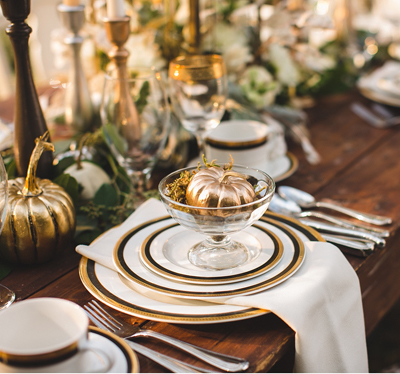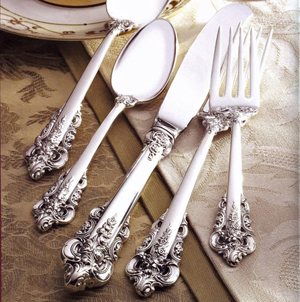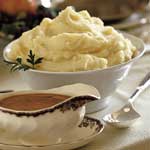Sometimes, learning to cook is the best thing a child can do
 In our house, the first smell of Thanksgiving was not turkey roasting or pumpkin pie but the bleach-sweet steam of my mother ironing the good tablecloth. I remember it from a time when I was small enough to creep unnoticed beneath the ironing board while she painstakingly transformed an undistinguished hump of wrinkled linen into a curtain of shimmering white. With a curt flick of her wrist, my mother sprinkled each length with water from a yellow, plastic bottle designed for this purpose, and then the iron would sizzle a path just above my head. Soon I was surrounded by a linen tent. The smell sparkled like hot stars.
In our house, the first smell of Thanksgiving was not turkey roasting or pumpkin pie but the bleach-sweet steam of my mother ironing the good tablecloth. I remember it from a time when I was small enough to creep unnoticed beneath the ironing board while she painstakingly transformed an undistinguished hump of wrinkled linen into a curtain of shimmering white. With a curt flick of her wrist, my mother sprinkled each length with water from a yellow, plastic bottle designed for this purpose, and then the iron would sizzle a path just above my head. Soon I was surrounded by a linen tent. The smell sparkled like hot stars.
So my Thanksgiving apprenticeship began.
Discovered, I was set to work folding the napkins, the first task allotted to small children wanting to be holiday helpers. The next year, I was allowed to place them beside each plate. My eyes were not that much higher than the table's surface and it seemed the most glamorous thing I had ever seen, a snowy landscape forested by crystal trees, glittering with silver and dishes of every size.
 Eventually I was allowed to handle the silver, though it would not be until I was 7 or 8 that I was trusted with the china, a year more before I could draw the crystal goblets from the depths of the buffet on my own. But in our house, the lure of the silver drawer was the most irresistible. Lined in purple felt and covered with an attached chamois of the same color, it seemed impossibly sumptuous, especially when compared with the jelly-jar-glass ordinariness of our everyday dinnerware.
Eventually I was allowed to handle the silver, though it would not be until I was 7 or 8 that I was trusted with the china, a year more before I could draw the crystal goblets from the depths of the buffet on my own. But in our house, the lure of the silver drawer was the most irresistible. Lined in purple felt and covered with an attached chamois of the same color, it seemed impossibly sumptuous, especially when compared with the jelly-jar-glass ordinariness of our everyday dinnerware.
The dull clatter of the fork tines when the drawer was pulled open, the upright regiment of knives each in their separate partitions, everything about it spoke of secret riches. Sometimes, on non-holidays, my mother would open it and let my brother and me lift out our wee baby spoons, which also resided there, but the only time we got to touch the real silver was on holidays.
In the kitchen, there was a similar hierarchy of tasks--the first cooking-related chore was the slicing of the cranberry sauce. We always served canned cranberry sauce, the jelled kind that bore the ridged imprints of the can after it slid out, with a wet thump, into the dish. Even a child could cut fairly even slices with these striations as a guide.
Soon, I was also allowed to put butter pats on all the appropriate vegetables, and assign serving spoons for each dish. I was working my way up the ladder to mixing the (boxed) mash potatoes and heating the peas when the trajectory of my career in the Thanksgiving kitchen spiked dramatically. I was 11 or 12 when I took over completely.
There were troubles in my family, as in many families, that crested to a scalding boil as the holidays began. My mother always hosted the dinner and as the years went by, it had become a joyless task and time. I don't remember the exact sequence of events but I do remember thinking, as so many eldest children have thought, that it would just be easier on everyone if I did it all myself. I'm sure I was trying to gain something--admiration or gratitude, extra love--but I was also trying to claim something of a sanctuary. In the kitchen, on Thanksgiving and Christmas, I ran my own life. If only for a few hours.
Fortunately, after years of watching my mother, I also knew how to cook. But a kitchen run by a child is very different thing than a kitchen run by an adult. Where my mother was a perfectionist, I was an approximist, fudging my way through recipes that soon became lost under the piles of unwashed measuring cups, butter wrappers and empty cans that I simply left where they fell.
My standard menu was basic, but quite extensive, so when I ran out of burners, I simply turned every knob to medium and filled the stove top with pots and pans, reasoning that everything would cook eventually. I also set up hot plates around the kitchen so things could get done in advance and still stay warm.
 This created a cat's cradle of extension cords and I remember once tripping over one and sending to the floor a pot full of peas and one of creamed parsnips. Now, creamed parsnips were about the only thing my mother ate at Thanksgiving so I wasn't about to show up at the table without them. I carefully scooped those that did not seem in direct contact with the floor back in the pot; the peas had a larger fall-out radius but those I could just wash and re-heat and slather with a little extra butter.
This created a cat's cradle of extension cords and I remember once tripping over one and sending to the floor a pot full of peas and one of creamed parsnips. Now, creamed parsnips were about the only thing my mother ate at Thanksgiving so I wasn't about to show up at the table without them. I carefully scooped those that did not seem in direct contact with the floor back in the pot; the peas had a larger fall-out radius but those I could just wash and re-heat and slather with a little extra butter.
I managed small rebellions in the kitchen--I began mashing actual potatoes, got rid of the turnips I found so loathsome, used butter instead of the tubbed margarine, added apples or walnuts or sausage to the stuffing. In young adulthood, giddy with a year or two of living out of a wok in New York, I substituted stir-fried broccoli in black bean sauce for my family's beloved Le Sueur baby peas in the fancy silver can. I might as well have served dead spider pie. Root vegetables are one thing, but peas, as it turns out, are Thanksgiving canon.
Originally published in the Los Angeles Times
Mary McNamara's mashed potatoes:
Cut up a bunch of potatoes, skins still on, boil; mash with a potato masher, add loads of butter, milk, salt and pepper until it looks and tastes right.
Mix with a wooden spoon, no food processors or mix masters please.
Mary McNamara is a Los Angeles Times Staff Writer

